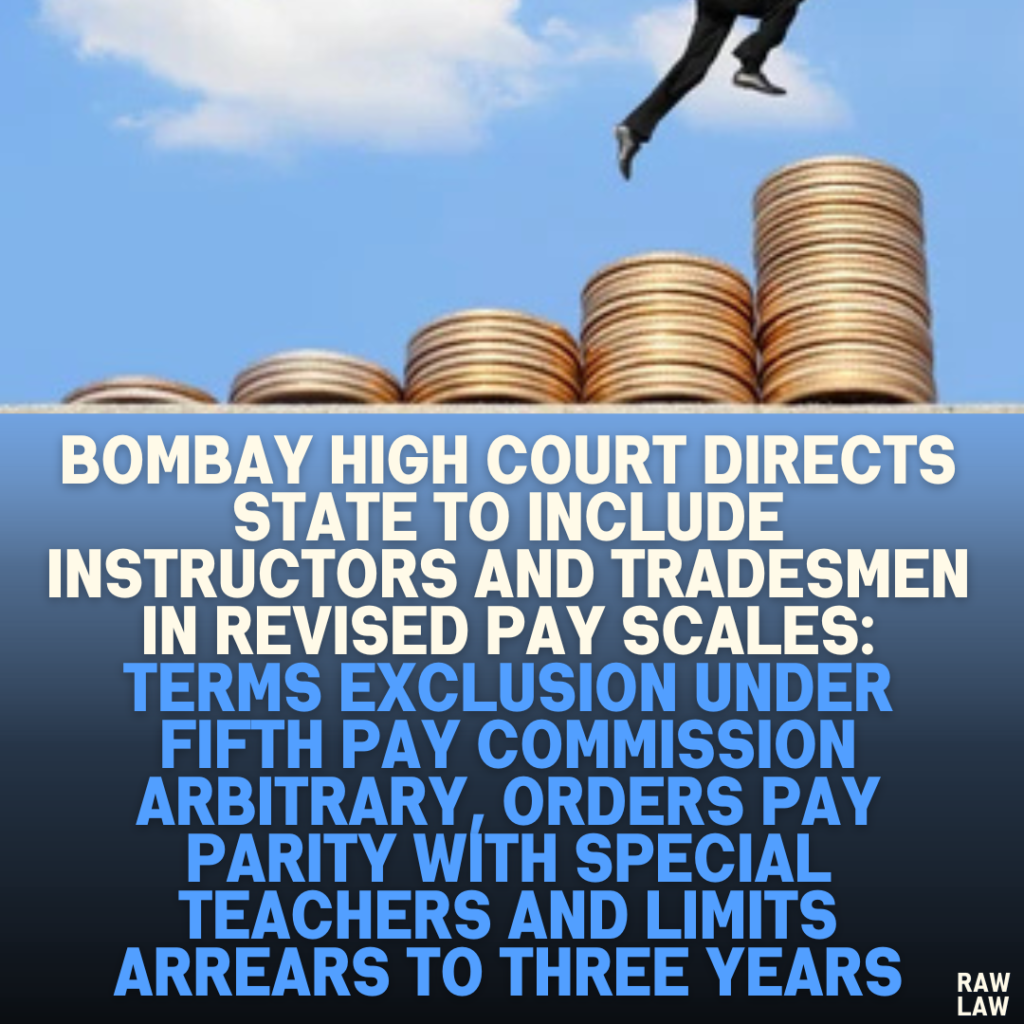Court’s Decision:
The Bombay High Court held that the exclusion of Instructors and Tradesmen from the revised pay scales under the Fifth Pay Commission was arbitrary and without valid justification. The Court directed the State of Maharashtra to:
- Include the posts of Instructors and Tradesmen in the Government Resolution dated 26-04-2012.
- Pay the petitioners at par with Special Teachers employed in Zilla Parishad and private schools for the physically challenged.
- Restrict arrears of pay to three years prior to the filing of the writ petition (from 07-10-2017).
This decision upholds fairness in public employment and rectifies the pay disparity.
Facts:
The petitioners are Instructors and Tradesmen employed in government institutions catering to visually impaired, hearing-impaired, and orthopedically challenged individuals. Initially, their pay scales were at par with Special Teachers across government, Zilla Parishad, and private schools. However, the Government Resolution dated 26-04-2012 excluded these posts from the revised pay scales under the Fifth Pay Commission. Despite earlier court directions and their repeated representations, the State failed to address the anomaly.
Key events:
- Until 1998, Instructors were paid the same as Special Teachers.
- The Fifth Pay Commission created disparity by excluding Instructors from revised pay scales.
- The petitioners filed a writ petition after prolonged inaction by the State.
Issues:
- Was the exclusion of Instructors and Tradesmen from the pay revision under the Fifth Pay Commission arbitrary and discriminatory?
- Should the petitioners be granted pay parity and arrears at par with Special Teachers?
Petitioner’s Arguments:
- Historical Pay Parity: The petitioners argued that they were historically paid at par with Special Teachers until the Fifth Pay Commission.
- Arbitrary Exclusion: The exclusion of their posts from the revised pay scales was unjustified, as their duties and responsibilities were similar to those of Special Teachers.
- Previous Directions: Despite previous court orders, the State failed to resolve their grievances.
- Relief Sought: They sought inclusion in the Government Resolution dated 26-04-2012 and payment of arrears.
Respondent’s Arguments:
- Duties Differed: The State claimed that the duties of Instructors were different from those of Special Teachers, justifying their exclusion.
- Pending Approval: The inclusion of Instructors in the pay revision was under consideration and required approval from the Finance Department.
- Arrears Denied: The arrears could not be granted since the Sixth Pay Commission had already been implemented.
Analysis of the Law:
The Court critically analyzed the claims and found:
- No Substantive Justification: The State failed to provide objective evidence or valid reasons for excluding the posts of Instructors and Tradesmen from the revised pay scales.
- Arbitrary Action: The exclusion was arbitrary, as the duties of Instructors were historically acknowledged to be on par with those of Special Teachers.
- Non-Compliance: The State’s failure to comply with previous court orders to address the anomaly indicated a disregard for the petitioners’ rights.
Precedent Analysis:
The Court referred to Union of India v. Tarsem Singh (2008) 8 SCC 648, which restricts the grant of arrears to three years prior to the filing of a writ petition. Applying this precedent, the Court allowed pay parity but limited the arrears to the specified period.
Court’s Reasoning:
- Historical Pay Parity: The Court noted that Instructors were historically treated on par with Special Teachers, both in pay and in responsibilities.
- Unexplained Exclusion: The State failed to provide any cogent reason for excluding the posts of Instructors from the Government Resolution dated 26-04-2012.
- Inadequate Affidavits: The affidavits filed by the State were vague, evasive, and failed to substantiate their justification for the exclusion.
- Arbitrariness: The exclusion of Instructors from the revised pay scales was arbitrary and violated principles of equality.
Conclusion:
- The writ petition was allowed.
- The State was directed to include the posts of Instructors and Tradesmen in the Government Resolution dated 26-04-2012.
- The petitioners were granted pay parity with Special Teachers, with arrears restricted to three years prior to the filing of the petition.
- The State was ordered to complete the process of pay fixation and disburse arrears within six months.
Implications:
- Strengthening Equality in Public Employment: This judgment underscores the principle that employees with similar responsibilities should receive equal pay, preventing arbitrary discrimination.
- Enforcement of Accountability: The case highlights the importance of government accountability in implementing court orders and resolving pay anomalies.
- Guidance for Similar Cases: This judgment sets a precedent for addressing pay disparities in public employment and reinforces reliance on objective justification for policy decisions.




Pingback: Delhi High Court Dismisses Revenue’s Appeal: “Section 115JB Not Applicable to Electricity Companies Before 2012 Amendment”; Upholds ITAT Ruling for AY 2008-09 - Raw Law